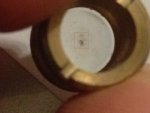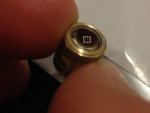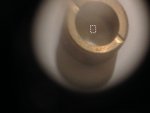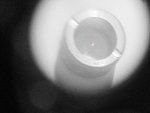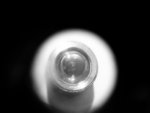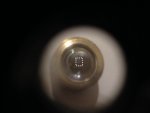grainde
0
- Joined
- Jan 29, 2012
- Messages
- 3,163
- Points
- 113
Re: Do not use 3 element lenses with high power lasers!
Yep similar here, the raw output is missing quite a few lines and the output looks like a single mode with the 3 element. Interestingly the power went back up to around 500 mW with the 3 element. So it's now a 500 mW single mode 465...
As mentioned I didn't think that 4 A was too much, but perhaps we should start collecting data, it may very well be possible that 3.5 A is the max.:beer:
Well it's either heat from run times that are too long, the diode which isn't able to handle the current, oxygen killing them or all of the above. In my case the diode was on for max 1 min during current setting, focusing and one "on moment" to enjoy the beam out of the window. In all cases, I never ran it constantly for more than 10 secs. So I don't think oxygen was the case here, due to the limited time factor. If some one wanted to test this they could remove the GBall flush the lens area with Argon or Nitrogen and whilst flushing screw in a lens barrel wrapped with teflon tape to help seal it. They would have to screw in the lens barrel to set the focus and not move it to avoid sucking in air. Two diodes could be compared in identical builds; one with the inert gas and the other with air and tested to see if there is any degradation over time. A third build with a GBall could be used as a control.:beer:
In all cases, I never ran it constantly for more than 10 secs. So I don't think oxygen was the case here, due to the limited time factor. If some one wanted to test this they could remove the GBall flush the lens area with Argon or Nitrogen and whilst flushing screw in a lens barrel wrapped with teflon tape to help seal it. They would have to screw in the lens barrel to set the focus and not move it to avoid sucking in air. Two diodes could be compared in identical builds; one with the inert gas and the other with air and tested to see if there is any degradation over time. A third build with a GBall could be used as a control.:beer:
See above, my guess would be that they are. :beer:
I had that same diode die on me too, but using a G2 lens and it did the same thing, went down to low output but with a dark slice in the middle of the beam after that. I believe we cannot drive them at 4 amps, probably better at 3 amps. Mine died at 3.5 amps.
Yep similar here, the raw output is missing quite a few lines and the output looks like a single mode with the 3 element. Interestingly the power went back up to around 500 mW with the 3 element. So it's now a 500 mW single mode 465...
As mentioned I didn't think that 4 A was too much, but perhaps we should start collecting data, it may very well be possible that 3.5 A is the max.:beer:
I have seen several NUBM07E diodes get weaker and weaker, every single one was run at 3.5 amps and had the GBall/can removed, I think the problem is oxygen, but I have not done a comparative study with a GBall intact diode, but I speculate that they would retain brightness longer with the GBall/can left intact.
-----edit-----
Ha, I remember looking at the raw output of the last 07 I had while the GBall was intact and it was mounted in a heatsinked HH of course, then not a day after removing the GBall/can I pulled the G7 lens I was using and noticed a dark line in the raw output. That diode also got weak in short order after the GBall/can was removed.
My NUBM08 lasted 6 weeks to about half brightness ( estimated ) , it lost it's burning ability over the weeks as I burn at a 20-30 foot distance often and I remember it got harder and harder to make it light a paper bag, but when I put a NUBM44 unit on the task " poof " up in flames no problem.
Well it's either heat from run times that are too long, the diode which isn't able to handle the current, oxygen killing them or all of the above. In my case the diode was on for max 1 min during current setting, focusing and one "on moment" to enjoy the beam out of the window.
Wish I knew if the manufacturer fills them with inert gas, but for that to work the GBall lens would need to have an air tight seal. If we knew that, we would know if oxygen is the problem or these diodes just don't like to be run so hard.
See above, my guess would be that they are. :beer:
Last edited:





